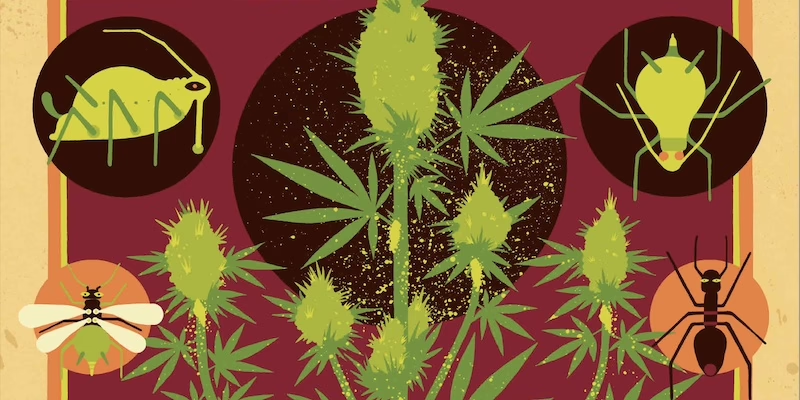
¡Hola, mundo!
Te damos la bienvenida a WordPress. Esta es tu primera entrada. Edítala o bórrala, ¡luego empieza a escribir!

One of the most annoying problems you may encounter when growing cannabis is a plague of aphids. You might get a little spooked when you see them for the first time, but there’s no need to worry: this guide will help you identify the signs of an aphid infestation and will show you proven methods to quickly get rid of them.
Aphids form a single and very large group of insects: the Aphidoidea superfamily, which belongs to the Hemiptera order. Present on Earth since the Jurassic period, their adaptive capacity has made them one of the most widely distributed insects in the world, with around 5,000 different sap-sucking species. As sap is literally the blood of everything green that grows, aphids are, in a very real sense, the vampires of the plant kingdom.
These Hemiptera have a soft, pear-shaped body between 1 and 3 mm in length; with six legs, a pair of antennae, and three body segments: head, thorax, and abdomen. Some have wings; others are covered in wax; and there are some which have a dusty appearance. But what sets them apart from all other insects is a pair of ‘cornicles’ that extend like exhaust pipes from their abdomen, through which they excrete defensive compounds (waxes and pheromones).
The aphids which attack cannabis plants showcase a wide range of colours, although they often have a light tone. As time goes on and the growing season progresses, you’ll see darker tones, ranging from green to brown or even black.
Aphids feed by perforating the plant tissue and sucking the sap with the help of a mouthpart that is similar to a straw (called a ‘stylet’). Sap has a low protein content but is rich in sugars. As aphids need to extract large amounts of sap to get enough protein, they expel the sugar excess through their anus in the form of honeydew.
This shiny, sugary honeydew attracts ants, which treat aphids as their own colony, looking after them and protecting them from predators. When ants are thirsty, they herd the aphids with their antennae to sip on their sweet nectar. Therefore, this symbiotic protective behaviour translates into a major obstacle to the work of the natural enemies of aphids, which often cannot even get near them.
This honeydew also attracts opportunistic fungi that can cover plant tissue with sooty mould, causing necrosis and reducing photosynthesis on the leaves. Aphids are also vectors of hundreds of diseases, as they can transfer viruses, bacteria, and fungi from one plant to another.
An aphid infestation can cause the leaves to curl, produce wilting or delay in the growth of the new shoots, and can even cause a general decrease in vigour. Once their number is too high and they’ve started to deform and curl the leaves, aphids are hard to control because the curled leaves actually protect them from insecticides and natural enemies.

The main power of aphids is their ability to multiply. In fact, they’re experts in reproduction, as they can have offspring either sexually or asexually, with both methods helping them to be highly resistant to their total destruction.
For most of the year, female aphids give birth to live offspring that are effectively their own clones, without the involvement of sexual reproduction. These nymphs are born pregnant with the next generation of aphids and will start giving birth to them one or two weeks later. This means that the aphids you’ll find in your grow will often be pregnant females, which can give birth to 5 – 6 nymphs per day.
When their population grows enough and the plant resources become short, female aphids start to give birth to a new type of winged clones, called ‘alates’. These are genetically identical to their wingless mothers but have the ability to conquer the air to find new plants to colonise, so they can lay their eggs on the leaves when they land on them.
To top it all off, male aphids start a mating ritual in late summer, which results in the sexual reproduction of aphids to ensure genetic diversity. After mating, the females lay their eggs on the stems and leaves, where they’ll spend the winter until hatching in early spring, when the next generation of aphids will return to take up residence on the plants.
Although aphids do everything possible to hide and protect themselves in colonies, you can normally find them with a quick look, as they wander around the underside of the leaves and the most tender stems. As their feeding causes very little injury to the plant, you won’t find any symptoms in the leaves, like the white spots or scars produced by mites or thrips.
Honeydew can easily give their presence away. And, as they grow, they need to periodically shed their external ‘skin’ (or exoskeleton) for a larger one, so they end up leaving a pile of whitish skins on the leaves as if they were the rotting dead remains on a battlefield.
Prevention and cleanliness are the best practices when growing your cannabis seeds. Below you’ll find some top tips on how to prevent aphids from attacking your precious marijuana plants:

If you detect aphids on your cannabis plants, you need to take action to get rid of them immediately:
The aphids that attack cannabis can be a real nuisance for growers, but it’s possible to get rid of them without using harmful chemicals or damaging the plants. You can also buy cannabis seeds which are less prone to pest infestations. With all of the aphids or red spiders out of your way, you’ll be able to focus on producing your delicious buds to their maximum potential.